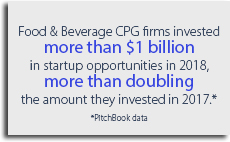
Food & Beverage Corporate Venture Funds; It’s what’s for Dinner
Established CPG players accelerate investment in emerging brands
Consumer preferences around food & beverages are shifting. Just ask the large Consumer Packaged Goods (CPG) companies. Younger consumers have taken the “you are what you eat” mantra to a whole new level, demanding products that fit into broader lifestyle habits and align with their habits and beliefs.
With this macro trend continuing to play out, smaller food & beverage brands, often better able to address millennial and generation Z consumer demands, are taking market share from the large CPG players. According to IRI's recent New Product Pacesetters Report, approximately half of the top-ranking brands launched in the U.S. last year came from smaller food manufacturers, with annual sales of less than $1 billion. That statistic contrasts starkly with numbers from five years ago when 90% of the “pacesetters” launched were simply extensions of existing brand lines. As millennials and generation Z become a more potent share of the consuming public, this trend represents a significant threat to the established CPG players.
CPGs have long employed a conventional M&A approach to upstart, high-growth, competitive brands: majority equity, control acquisitions and post-close absorption into the parent company’s functional infrastructure. However, the strategy to simply acquire earlier stage companies and then integrate / assimilate those emerging brands into the larger CPG portfolios has been met with mixed results. In some cases, large CPG players have had to subsequently retrench and divest some of the emerging brands that simply didn’t or couldn’t fit into a holistic brand and product strategy, as those brands became a corporate distraction, or worse, cash-flow drains.
 A complementary strategy that has emerged in the past decade is to create internal venture-capital style “funds” to identify and then invest in emerging brands. This strategy carries multiple theoretical benefits for the CPG investors:
A complementary strategy that has emerged in the past decade is to create internal venture-capital style “funds” to identify and then invest in emerging brands. This strategy carries multiple theoretical benefits for the CPG investors:
- Learning from more nimble business models through:
- Innovative product sourcing, development, and packaging techniques;
- Grass roots marketing tactics with cultural / societal brand narratives that resonate with the next generations of consumers; and
- Decentralized approaches that preserve emerging brand identities and independence.
- Enjoying more flexible economic and governance terms
- Facilitating direct access for future opportunities to own more equity in the emerging brands as they grow, thereby priming the M&A pipeline.
Benefits for the emerging brand partners are also meaningful:
- Tapping into valuable capital and resources (e.g., distribution networks), enabling them to grow faster;
- Accessing critical consumer data to help refine go-to-market strategies; and
- Establishing runways to subsequent majority control acquisitions with the CPG investors.
Many CPGs including General Mills, Kraft Heinz, Kellogg, Tyson, and Campbell, among others, have employed this “VC-style” strategy. Their approaches vary, with some CPGs adopting setups that are akin to incubators / accelerators, and others utilizing more formalized setups with VC industry veterans leading structured teams that adhere to rigorous financial thresholds.
The successful examples of emerging brand partnerships are generally rooted in true collaborations with meaningful mutual benefits. In these instances, the CPG and the emerging brand enjoy a virtuous cycle of learning from each other and translating those lessons into accelerated growth, all without disrupting the essence of what makes the emerging brand successful and without distracting the CPG from its core strategic initiatives. Successful partnerships also avoid or mitigate the inherent competitive tensions that can exist between emerging brands and their larger CPG partners. Balancing these various factors is complicated and has, in some cases, resulted in misalignment.
Notwithstanding the potential pitfalls, CPGs appear to be doubling down on this strategy, with many companies parlaying their early VC efforts into larger commitments to the strategy. While only a small fraction of global VC deals included CPGs in 2010, CPG investments now represent a third of all VC deals today. PitchBook data reveals that food & beverage CPG firms invested more than $1 billion in startup opportunities in 2018, more than doubling the amount they invested in startups in 2017.
Overall, Baird believes this venture funding strategy in food & beverage is a positive one. CPG players have learned from previous missteps in their early days and now are actively engaging with the new era of consumer demands by partnering with emerging brands that address the new consumer paradigm. Their VC arms are enabling them to move more nimbly and participate in a fluid food & beverage landscape that features many, smaller brands taking share rapidly.
Traditional venture capitalists still dominate the investor arena and offer emerging brands myriad choices, in addition to CPG VC investors. And there is also the new advent of “covert craft” brands, whereby CPGs create in-house brands that mimic the look and feel of small, independent upstart brands instead of acquiring existing brands. Some of the largest global CPGs have begun utilizing this stealthy strategy, but only time will tell if “covert craft” will be a viable adjunct to more widely reported M&A and VC-investing efforts.
Baird’s global Food & Beverage practice continues to monitor these trends and actively work with its clients to pursue the best path(s).